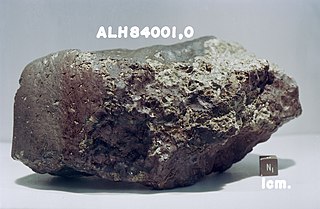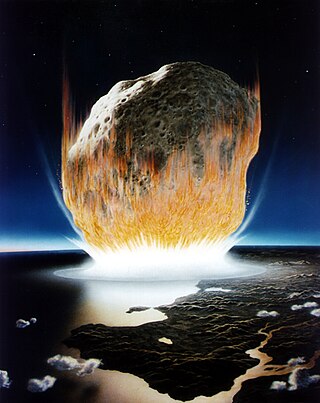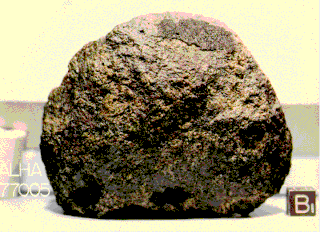
Astrobiology is a scientific field within the life and environmental sciences that studies the origins, early evolution, distribution, and future of life in the universe by investigating its deterministic conditions and contingent events. As a discipline, astrobiology is founded on the premise that life may exist beyond Earth.

Panspermia is the hypothesis that life exists throughout the Universe, distributed by space dust, meteoroids, asteroids, comets, and planetoids, as well as by spacecraft carrying unintended contamination by microorganisms, known as directed panspermia. The theory argues that life did not originate on Earth, but instead evolved somewhere else and seeded life as we know it.

A Martian meteorite is a rock that formed on Mars, was ejected from the planet by an impact event, and traversed interplanetary space before landing on Earth as a meteorite. As of September 2020, 277 meteorites had been classified as Martian, less than half a percent of the 72,000 meteorites that have been classified. The largest complete, uncut Martian meteorite, Taoudenni 002, was recovered in Mali in early 2021. It weighs 14.5 kilograms and is on display at the Maine Mineral and Gem Museum.

Allan Hills 84001 (ALH84001) is a fragment of a Martian meteorite that was found in the Allan Hills in Antarctica on December 27, 1984, by a team of American meteorite hunters from the ANSMET project. Like other members of the shergottite–nakhlite–chassignite (SNC) group of meteorites, ALH84001 is thought to have originated on Mars. However, it does not fit into any of the previously discovered SNC groups. Its mass upon discovery was 1.93 kilograms (4.3 lb).

Nanobacterium is the unit or member name of a former proposed class of living organisms, specifically cell-walled microorganisms, now discredited, with a size much smaller than the generally accepted lower limit for life. Originally based on observed nano-scale structures in geological formations, the status of nanobacteria was controversial, with some researchers suggesting they are a new class of living organism capable of incorporating radiolabeled uridine, and others attributing to them a simpler, abiotic nature. One skeptic dubbed them "the cold fusion of microbiology", in reference to a notorious episode of supposed erroneous science. The term "calcifying nanoparticles" (CNPs) has also been used as a conservative name regarding their possible status as a life form.
The possibility of life on Mars is a subject of interest in astrobiology due to the planet's proximity and similarities to Earth. To date, no conclusive evidence of past or present life has been found on Mars. Cumulative evidence suggests that during the ancient Noachian time period, the surface environment of Mars had liquid water and may have been habitable for microorganisms, but habitable conditions do not necessarily indicate life.
A biosignature is any substance – such as an element, isotope, molecule, or phenomenon – that provides scientific evidence of past or present life on a planet. Measurable attributes of life include its physical or chemical structures, its use of free energy, and the production of biomass and wastes.

Planetary protection is a guiding principle in the design of an interplanetary mission, aiming to prevent biological contamination of both the target celestial body and the Earth in the case of sample-return missions. Planetary protection reflects both the unknown nature of the space environment and the desire of the scientific community to preserve the pristine nature of celestial bodies until they can be studied in detail.

Eos Chasma is a chasma in the southern part of the Valles Marineris canyon system of the Coprates quadrangle and the Margaritifer Sinus quadrangles of the planet Mars.
Non-cellular life, also known as acellular life, is life that exists without a cellular structure for at least part of its life cycle. Historically, most definitions of life postulated that an organism must be composed of one or more cells, but, for some, this is no longer considered necessary, and modern criteria allow for forms of life based on other structural arrangements.

Nakhla is a Martian meteorite which fell in Egypt in 1911. It was the first meteorite reported from Egypt, the first one to suggest signs of aqueous processes on Mars, and the prototype for Nakhlite type of meteorites.
E. Imre Friedmann was a biologist, Robert O. Lawton Distinguished Professor of Biology at Florida State University and the NASA Ames Research Center, and Director, Polar Desert Research Center. He studied endolithic microbial communities and astrobiology. After escaping the Holocaust, Friedmann received his Ph.D. in botany from the University of Vienna, Austria in 1951, and he died on June 11, 2007.

EXPOSE is a multi-user facility mounted outside the International Space Station (ISS) dedicated to astrobiology. EXPOSE was developed by the European Space Agency (ESA) for long-term spaceflights and was designed to allow exposure of chemical and biological samples to outer space while recording data during exposure.
Ultramicrobacteria are bacteria that are smaller than 0.1 μm3 under all growth conditions. This term was coined in 1981, describing cocci in seawater that were less than 0.3 μm in diameter. Ultramicrobacteria have also been recovered from soil and appear to be a mixture of gram-positive, gram-negative and cell-wall-lacking species. Ultramicrobacteria possess a relatively high surface-area-to-volume ratio due to their small size, which aids in growth under oligotrophic conditions. The relatively small size of ultramicrobacteria also enables parasitism of larger organisms; some ultramicrobacteria have been observed to be obligate or facultative parasites of various eukaryotes and prokaryotes. One factor allowing ultramicrobacteria to achieve their small size seems to be genome minimization such as in the case of the ultramicrobacterium P. ubique whose small 1.3 Mb genome is seemingly devoid of extraneous genetic elements like non-coding DNA, transposons, extrachromosomal elements etc. However, genomic data from ultramicrobacteria is lacking since the study of ultramicrobacteria, like many other prokaryotes, is hindered by difficulties in cultivating them.
Interplanetary contamination refers to biological contamination of a planetary body by a space probe or spacecraft, either deliberate or unintentional.

Impact survival is a theory that life, usually in the form of microbial bacteria, can survive under the extreme conditions of a major impact event, such as a meteorite striking the surface of a planet. This step is necessary for the possibility of panspermia. Microbial life must be able to survive both the escape out of a planetary atmosphere - likely due to a major impact - as well as the re-entry through the atmosphere, of and collision with, a second planetary body.

Yamato 000593 is the second largest meteorite from Mars found on Earth. Studies suggest the Martian meteorite was formed about 1.3 billion years ago from a lava flow on Mars. An impact occurred on Mars about 11 million years ago and ejected the meteorite from the Martian surface into space. The meteorite landed on Earth in Antarctica about 50,000 years ago. The mass of the meteorite is 13.7 kg (30 lb) and has been found to contain evidence of past water alteration.
Astro microbiology, or exo microbiology, is the study of microorganisms in outer space. It stems from an interdisciplinary approach, which incorporates both microbiology and astrobiology. Astrobiology's efforts are aimed at understanding the origins of life and the search for life other than on Earth. Because microorganisms are the most widespread form of life on Earth, and are capable of colonising almost any environment, scientists usually focus on microbial life in the field of astrobiology. Moreover, small and simple cells usually evolve first on a planet rather than larger, multicellular organisms, and have an increased likelihood of being transported from one planet to another via the panspermia theory.

Allan Hills 77005 is a Martian meteorite that was found in the Allan Hills of Antarctica in 1977 by a Japanese National Institute of Polar Research mission team and ANSMET. Like other members of the group of SNCs, ALH-77005 is thought to be from Mars.












